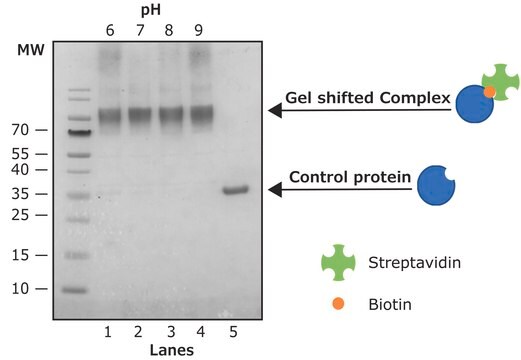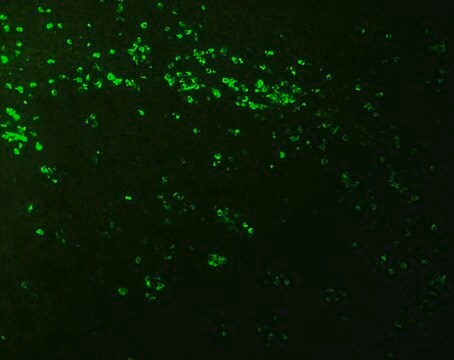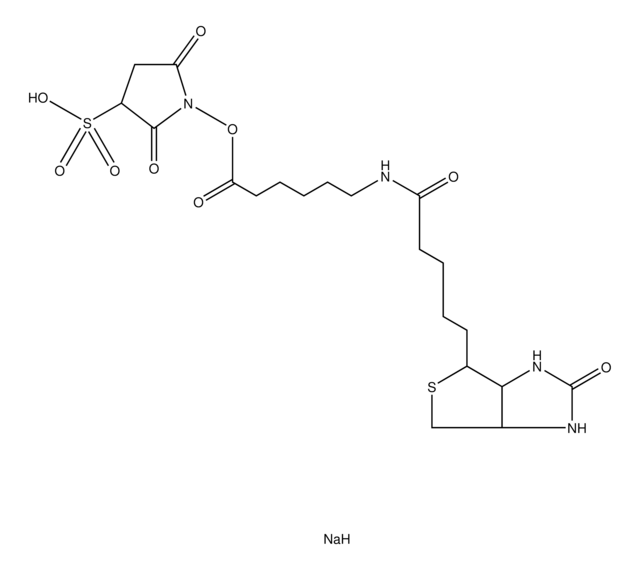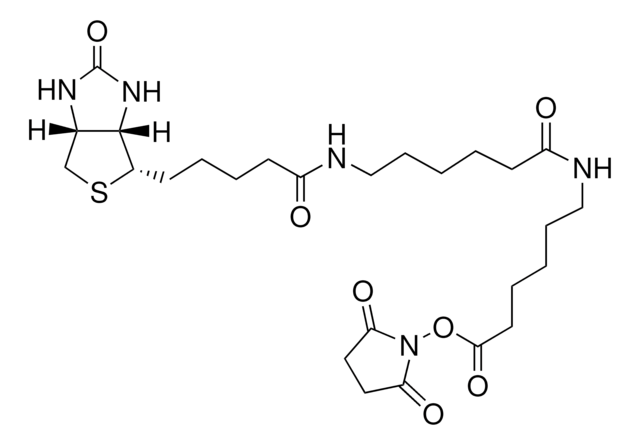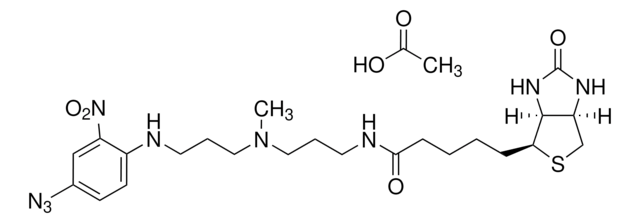Wszystkie zdjęcia(1)
Kluczowe dokumenty
BTAG
BiotinTag™ Micro Biotinylation Kit
Synonim(y):
Biotinylation Kits
Zaloguj sięWyświetlanie cen organizacyjnych i kontraktowych
About This Item
Kod UNSPSC:
12352200
NACRES:
NA.32
Polecane produkty
Szukasz podobnych produktów? Odwiedź Przewodnik dotyczący porównywania produktów
Opis ogólny
For custom biotinylation of proteins, Sigma offers kits for conjugation on two different scales. The biotin-avidin system has become popular when high sensitivity and specificity are desired. Biotin can be conjugated to antibodies, lectins, enzymes, and other proteins. The protocols in the kits have been optimized for antibodies. Avidin binds to biotin with a high affinity (Ka = 1015 M) and specificity. When conjugated to enzymes or fluorochromes avidin provides a means of identifying biotinylated compounds via enzymatic conversion of substrate to form a visible product or detection of fluorescence by spectrophotometry or flow cytometry.
Zastosowanie
BiotinTag™ Micro Biotinylation Kit has been used to generate biotylanted IgG2a antibody conjugate and in the biotinylation of interleukin 9 receptor α (IL-9Rα) and thymic stromal lymphopoietin α (TSLPRα).
Biotin has been modified with aminocaproate, then activated via an ester linkage with sulfo-N-hydroxysuccinimide (BAC-Sulfo-NHS). Aminocaproate provides a six-carbon spacer that reduces steric hindrance on the biotin and improves accessibility to the binding site on avidin. Sulfonation of the hydroxysuccinimide increases the polarity of the reagent, allowing it to dissolve easily in aqueous buffer. The ester provides a carbonyl carbon adjacent to a labile ester linkage as a target for primary amine side chains of accessible lysine residues, joining the biotinamidocaproate to the protein via an amide bond.
Cechy i korzyści
- Complete protocols for labeling and assay
- BAC-Sulfo-NHS is completely water soluble
- No DMF or DMSO needed
- Biotinylation occurs near neutral pH and physiological ionic strength, avoiding harsh conditions that could damage sensitive proteins
- Fast separation of conjugate from reactants using gel filtration
- 2-5 molar ratio biotin to protein in conjugate (for antibodies)
1 mg protein per reaction (B-TAG)
10 mg protein per reaction (BK-101)
• Sufficient reagents for at least 5 labelings
Komentarz do analizy
Procedure:
Conjugation is performed in four easy steps:
1. Reconstitute BAC-Sulfo-NHS with Phosphate Buffer (PB).
2. Add BAC-Sulfo-NHS to protein and allow to react for 30 minutes at room temperature.
3. Separate the conjugate from the reactants on gel filtration.
4. Assay the conjugate for biotin incorporation by the avidin-HABA assay (BK-101 only). Conjugate is ready to use.
Conjugation is performed in four easy steps:
1. Reconstitute BAC-Sulfo-NHS with Phosphate Buffer (PB).
2. Add BAC-Sulfo-NHS to protein and allow to react for 30 minutes at room temperature.
3. Separate the conjugate from the reactants on gel filtration.
4. Assay the conjugate for biotin incorporation by the avidin-HABA assay (BK-101 only). Conjugate is ready to use.
Informacje prawne
BiotinTag is a trademark of Sigma-Aldrich Co. LLC
Ta strona może zawierać tekst przetłumaczony maszynowo.
Hasło ostrzegawcze
Warning
Zwroty wskazujące rodzaj zagrożenia
Zwroty wskazujące środki ostrożności
Klasyfikacja zagrożeń
Skin Sens. 1
Kod klasy składowania
10 - Combustible liquids
Klasa zagrożenia wodnego (WGK)
WGK 2
Wybierz jedną z najnowszych wersji:
Masz już ten produkt?
Dokumenty związane z niedawno zakupionymi produktami zostały zamieszczone w Bibliotece dokumentów.
Klienci oglądali również te produkty
Quantum dot enabled lateral flow immunoassay for detection of cardiac biomarker NT-proBNP
Wilkins MD, et al.
Sensing and Bio-Sensing Research, 21, 46-53 (2018)
Ming Yang et al.
Viruses, 14(4) (2022-04-24)
Foot-and-mouth disease virus (FMDV) causes FMD, a highly contagious disease of cloven-hoofed animals including cattle, goats, pigs and sheep. Rapid detection of FMDV is critical to limit the devastating economic losses due to FMD. Current laboratory methods for FMDV detection
IL-2,-7, and-15, but not thymic stromal lymphopoeitin, redundantly govern CD4+ Foxp3+ regulatory T cell development
Vang KB, et al.
Journal of Immunology, 181(5), 3285-3290 (2008)
Nasz zespół naukowców ma doświadczenie we wszystkich obszarach badań, w tym w naukach przyrodniczych, materiałoznawstwie, syntezie chemicznej, chromatografii, analityce i wielu innych dziedzinach.
Skontaktuj się z zespołem ds. pomocy technicznej

